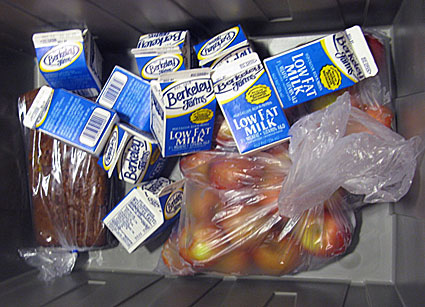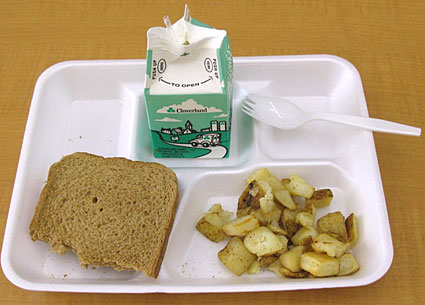Part 4 of Cafeteria Confidential: Berkeley, in which Ed Bruske reports on his recent week-long, firsthand look at how Berkeley, Calif., schools part ways from the typical school diet of frozen, industrially processed convenience foods. Cross-posted from The Slow Cook. And check out the rest of the Cafeteria Confidential series.
 Breakfasts for Berkeley schoolkids are simple, healthy — and cheap.(Ed Bruske photos)Around 8:30 each morning, students at the Martin Luther King, Jr. Middle School in Berkeley, Calif., cross an asphalt playground behind the main school building and begin drifting into a cafeteria and kitchen complex known as the Dining Commons to pick up breakfast for themselves and their classmates. They head for a set of rolling metal shelves holding gray, plastic bins, and carry one back to their classroom, where they dole out the food and fill out a roster indicating which students took the meal.
Breakfasts for Berkeley schoolkids are simple, healthy — and cheap.(Ed Bruske photos)Around 8:30 each morning, students at the Martin Luther King, Jr. Middle School in Berkeley, Calif., cross an asphalt playground behind the main school building and begin drifting into a cafeteria and kitchen complex known as the Dining Commons to pick up breakfast for themselves and their classmates. They head for a set of rolling metal shelves holding gray, plastic bins, and carry one back to their classroom, where they dole out the food and fill out a roster indicating which students took the meal.
One morning during my recent “internship” with the school’s central kitchen, I was assigned to load the bins. That day, the bins’ contents were a sliced loaf of homemade banana bread, kid-size Fuji and Golden Delicious apples (that I sealed in plastic bags), and cartons of plain organic milk.
I couldn’t believe how simple it was. Here in the District of Columbia, where my daughter attends fourth grade at a public elementary school, kids eat in cafeterias and get to choose hot items like breakfast pizza, eggs, or egg-and-cheese patties with bagels, in addition to brand-name cereals and a choice of four different milk varieties, including chocolate and strawberry.
The Berkeley breakfast seemed downright spartan by comparison. Yet those gray bins hold the key to the success of Berkeley’s cook-from-scratch program.
Mealing and dealing
When chef Ann Cooper was hired five years ago to help transform the Berkeley meal program from industrially processed convenience foods to meals cooked fresh from raw ingredients, one of the first things she did was examine the program’s finances. And there in the school system’s general budget she found certain “Meals for Needy” funds provided by the State of California. The state allocates $1.24 for each breakfast the school district serves to students who qualify for free or reduced-price meals, and that’s on top of the $1.46 the federal government pays for students who meet the subsidized breakfast criteria. But California does not require that “Meals for Needy” money actually be used for food. It can be directed anywhere in a school district’s budget. Cooper insisted that it be dedicated to her food operation.
“The ‘Meals for Needy’ money wasn’t going into meals, it was going into the general fund for other programs. Food services was running a negative balance,” Cooper recalls. “Ethically, I thought the money should go into school food. I said, ‘If you want us to grow the program and make it sustainable, you’re actually penalizing us if we don’t get this money.'”
In Cooper’s second year, the ‘Meals for Needy’ funds were reassigned to food services. It was a virtual bonanza of extra cash — $879,000 this year alone, out of a $3.7 million food budget.
But to really turbo-charge the deal, Berkeley schools decided to start serving breakfast in the classroom only for all its students except those in high school, who take breakfast in the cafeteria. To top it off, breakfast is universally free. There’s no reason for any student not to take it. Consequently, participation in the breakfast program exploded, from less than 9 percent of the district’s 9,100 students in 2005 to 61 percent this year. The figure might be much higher if high-schoolers participated, but shifting class schedules and the absence of home rooms in high school pose barriers, says Cooper. Only 4 percent of high school students take breakfast, compared to 96 percent of elementary- and middle-schoolers.
By comparison, barely 30 percent of students in the District of Columbia take advantage of the free breakfast the public school system offers, although a recently passed “Healthy Schools” bill would require the city’s schools to offer breakfast in classrooms where there is a high percentage of needy students.
“With current federal funding for the School Breakfast Program ranging from $1.16 to $1.74 for every breakfast served to students eligible for free and reduced meals, a Breakfast in the Classroom program — in which every child is served breakfast every day — can be a financial goldmine for severe-need school districts,” says school-food consultant Kate Adamick, citing the relatively low food and labor costs associated with producing that meal. “The net revenue generated by the breakfast program can then be used to help supplement the cost of providing a healthier school lunch.”
Since the average cost of making a school breakfast like the one I packed is only around $1.31 in Berkeley, the multiplier effect of receiving both state and federal funds, coupled with a captive audience created by serving breakfasts only in classrooms — and having students and teachers reduce labor costs by distributing the morning meal — makes breakfast a cash cow that is the envy of every administrator in Berkeley schools.
“There are lots of people who would love to get their hands on that ‘Meals for Needy’ money,” said Bonnie Christensen, the school district’s executive chef. “I tell them, take away our ‘Meals for Needy’ money and you won’t have a meals program any more.”
The extra funds go a long way toward compensating for what may have been over-exuberant expectations for the lunch program. Eric Weaver, one of the original parent activists behind the switch from processed to fresh food in Berkeley (see my last post, about the history of Berkeley’s school food revolution), said organizers knew that cooking from scratch would be more expensive, but they believed better food would induce more kids to participate. “The food cost is high. But if you’re selling twice as many lunches, the marginal cost is lower,” Weaver said.
In fact, student participation in the revamped lunch program has changed little since it started five years ago. The latest data show that 25.6 percent of Berkeley students took the federally subsidized lunch this year, compared to 24.5 percent in 2005, an increase of a little more than 1 percent. Participation among the 3,355 students at Berkeley High School has actually declined by nearly 16 percent, from a rate of 8.3 percent to 6.4 percent. Most high school students leave campus for lunch.
The extra revenue from breakfast helps pay for better food at lunch, as well as the additional labor it takes to prepare it. The average food cost for lunch meals in Berkeley schools is around $1.40, compared to $1 or less at most other schools around the country. Berkeley will feel a bit of a pinch in the fall, however. Because of California’s ongoing budget meltdown, the per-student grant of $1.24 for each breakfast under the “Meals for Needy” program is scheduled to drop to $1.17.
If Berkeley’s financial approach to breakfast sounds devilishly clever, it gets even better where student well-being is concerned. One of the reasons for moving breakfast to the classrooms was to remove the stigma students might feel standing in line for free meals. Even the truly needy will sometimes skip meals if it means revealing themselves as falling into the free or reduced-price category. About 41 percent of the Berkeley’s children qualify for either free or reduced-price meals based on family income.
“We want all of the kids to sit down and eat breakfast together,” says Christensen. “We don’t want the stigma. The way to make that happen is to have kids take breakfast as a whole.”
So much goodness in a small serving
Making breakfast simple also helps hold down costs and satisfies the environmental concerns of Berkeley parents by minimizing waste. I just wasn’t quite prepared for how pared down these breakfasts would be. In D.C., kids routinely load their trays with cereal, graham crackers, cookies or muffins, juice of one kind or another, and milk. The cereal comes in plastic tubs, into which kids can pour a carton of milk. When they’re through eating, the milk carton, the juice carton, plastic wrappers, the plastic tub, and the Styrofoam serving tray all are thrown in the trash, creating a mountain of waste for the landfill every day.
In Berkeley, the 1-ounce servings of cereal come in little plastic packets. It’s plastic, for sure, but nowhere near as much as a tub. I asked Christensen how the students were supposed to eat the cereal if they didn’t have anything in which to mix it with the milk. She motioned with her hands to indicate eating the cereal hand-to-mouth, then drinking the milk out of the carton. Or, the kids can pour the cereal directly into the mik carton. It sounded a little like camping to me — but it seems to work.
Something that also struck me immediately about the contents of the breakfast bins was the lower sugar content. One of the original goals of parents who led the fight to reform Berkeley school meals was to eliminate the use of high-fructose corn syrup in school food. Corn-derived HFCS has become a lightening rod for those who oppose industrial agriculture and the culture of subsidizing with tax dollars a style of farming that rewards the heavy use of artificial fertilizers and pesticides to raise commodity crops on a grand scale and penalizes small family farmers who struggle to provide local communities with sustainably grown produce — and there are plenty of those people in Berkeley.
Aside from its environmental impact, HFCS has also come under increasing scrutiny as an agent in the current epidemic of obesity. And fructose has been linked to an alarming rise in the incidence of non-alcoholic fatty liver disease. High-fructose corn syrup is the sweetener of choice in the chocolate- and strawberry-flavored milk that’s offered to District of Columbia schoolchildren at breakfast and lunch. Berkeley schools, by contrast, have eliminated flavored milk entirely, opting for plain milk instead — organic, to boot.
 A breakfast recently served to DC public schoolchildren, including my daughterKids in the District of Columbia sometimes consume 50 or 60 grams of sugar at breakfast alone, almost 15 teaspoons of sugar. From what I saw in the breakfast bins in Berkeley, I calculated that students there weren’t getting half that much. For instance, a 1.25-ounce tub of Raisin Bran cereal recently being served for breakfast at my daughter’s elementary school in D.C. contains 11 grams of sugar. That compares to 5 grams of sugar in the 1-ounce packet of Nature’s Path Organic Oaty Bites served in Berkeley. An 8-ounce carton of plain low-fat milk in Berkeley had 15 grams of sugar in the form of naturally occurring lactose, compared to 28 grams of sugar in the strawberry-flavored milk so many of the kids pour on their cereal in D.C.
A breakfast recently served to DC public schoolchildren, including my daughterKids in the District of Columbia sometimes consume 50 or 60 grams of sugar at breakfast alone, almost 15 teaspoons of sugar. From what I saw in the breakfast bins in Berkeley, I calculated that students there weren’t getting half that much. For instance, a 1.25-ounce tub of Raisin Bran cereal recently being served for breakfast at my daughter’s elementary school in D.C. contains 11 grams of sugar. That compares to 5 grams of sugar in the 1-ounce packet of Nature’s Path Organic Oaty Bites served in Berkeley. An 8-ounce carton of plain low-fat milk in Berkeley had 15 grams of sugar in the form of naturally occurring lactose, compared to 28 grams of sugar in the strawberry-flavored milk so many of the kids pour on their cereal in D.C.
In fact, milk consumption is optional under the “offered versus served” scheme that both Berkeley and D.C. use in their food service. “There is no documented case of any kid dying for lack of chocolate milk,” says Cooper.
“Sugar is an addictive substance. We don’t want to add calories with sugar,” explains Christensen. “Calories from sugar are not healthy. They provide no nutrition and the kids are just wired.” Fruit juice, because of its sugar content, is served only occasionally in Berkeley schools and as a substitute for milk, Christensen said. In D.C., juice is offered almost every day along with chocolate- and strawberry-flavored milk.
I also noticed there were no big-brand cereals in the Berkeley breakfasts. Most of the cereal served in D.C. — Apple Jacks, Cinnamon Toast Crunch, chocolate-flavored Little Bites Mini-Wheats — are made by General Mills or Kellogg’s.
“Kellogg’s is a big no, no for the parents around here,” says Christensen. “Marketing to kids is a big no-no.”
Big food companies give hefty “discounts” (some prefer to call them “kickbacks”) in order to have their products placed in school meal programs. It is widely assumed that for a huge school-food service company such as Chartwells, which contracts with more than 500 school districts around the country, including D.C. Public Schools, those discounts can add up to millions of dollars every year and grease the wheels for imprinting popular, sugary brands in the minds of schoolchildren nationwide.
It’s a murky area of the school food service business. A March 2009 article in In These Times magazine calculated that the big food service companies — Chartwells, Sodexo, Aramark — were taking in hundreds of millions of dollars in discounts annually in ways that ended up costing customers money by focusing food purchases on the large, national brands that can afford to give hefty discounts, rather than smaller, local companies that sell their goods more cheaply.
A 2002 audit by the U.S. Department of Agriculture found that in a sample of Midwestern school districts, food-service companies routinely were ignoring a rule that requires them to pass on any discounts they receive to the schools. They were just pocketing the money. In 2003, Robert Pritsker, a former New York City restaurateur living in Connecticut, independently filed suit against Chartwells, Aramark, and Sodexo in federal court in Philadelphia, claiming they had withheld from schools $1 billion going back to the 1990s, causing the schools to falsely claim they were complying with the federal rules. Pritsker’s suit recently was dismissed by a federal appellate court after a seven-year battle.
In 2008, the USDA beefed up its rule on discounts, requiring that school contracts with food service companies clearly state that any discounts received by the companies will be passed on to the schools. Still, the discounts act as a juicy incentive to choose mass-marketed products over healthier alternatives from smaller companies that can’t play the discount game. Pritsker believes the school food service giants operate on such a huge scale, they have ways to work around the USDA rules. Apparently, discount practices have caught the attention of some attorneys general in individual states.
“This is a huge, huge issue because it’s one of the reasons we’ll never make any progress in these districts that have food service contracts,” argues nutritionist and school food activist Susan Rubin. “These volume discounts are another insidious way that our kids get marketed to. Basically, we’re now saying that money is more important than our kids’ health.”
Next: Hold the beans, please! What kids want to eat




